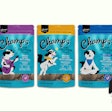After mercury was found in pet food in a 2016 research project at the University of Nevada, Reno, a new team is taking a closer look to quantify the concentration level of methylmercury, the toxic mercury compound that can have negative health impacts. Preliminary analyses of a few dog food samples showed methylmercury to be a significant percentage of the total mercury.
"As scientists at the University of Nevada, Reno and experts in the fields of mercury and genetic analyses, we want to learn more about what is really in pet foods and help consumers make a more informed decision when purchasing food for their pets," Sarrah Dunham-Cheatham, postdoctoral researcher in the Department of Natural Resources and Environmental Sciences, said. "But we need your help."
To fund their research, the scientists have collaborated with the University's development department to crowdfund the project. Donations to the project can be made through the University of Nevada, Reno Foundation. All donations are tax deductible.
"One hundred percent of the donation will be used for research," she said. "Our goal is to raise $25,000 for the entire project. This will cover the purchase of 100 or more pet food samples, as well as the costs to analyze the total mercury and methylmercury concentrations and genetic composition in the samples. No donation is too small; any amount is greatly appreciated."
The objectives for the project are:
1. to determine the total amount of mercury in pet foods and how much is present as methylmercury (a strong neurotoxin that is especially harmful to cats),
2. to use genetics to determine if the ingredients listed on the food package label are really what is in the food, and
3. to share the results with the public so that pet owners can be better informed when selecting pet food and treats to help keep their pet healthy and happy.
It is important to know how much methylmercury is in pet food because it is a potent neurotoxin - think "the Mad Hatter." Understanding the amount of methylmercury in pet food will allow a better understanding of the potential impact of long-term exposure on pets.
"We as humans often are exposed to unknown contaminants in our food; animals are even more susceptible to contaminants in food because they are fed the same food daily," Mae Gustin professor in the Natural Resources and Environmental Sciences Department, and who primarily conducts research on mercury in the environment, said. "It is important for people to know that the foods they are feeding their animals are safe. This information is important for manufacturers of pet food as well as for pet owners."
Under Gustin's direction, the previous undergraduate research project at the University investigated total mercury concentrations in 101 pet food samples, including wet and dry cat and dog food, and found that 14 pet food samples had mercury concentrations higher than considered safe for wildlife, and two exceeded concentrations acceptable for human consumption. The researchers also performed genetic analyses of some pet foods to determine if the ingredients in the food were the same as on the packaging label, and found that the ingredients and labeling did not match in some pet foods.
This project is under the supervision of Nevada Board of Regents Researcher and Foundation Professor Mae Gustin, College of Agriculture, Biotechnology, and Natural Resources Associate Professor Mike Teglas and Extension Educator Lindsay Chichester of the University of Nevada Cooperative Extension.
The project will provide research opportunities for undergraduate and graduate students.
Learn more about the project in the team's About section of their Facebook page, and @PetFoodMercury.
















